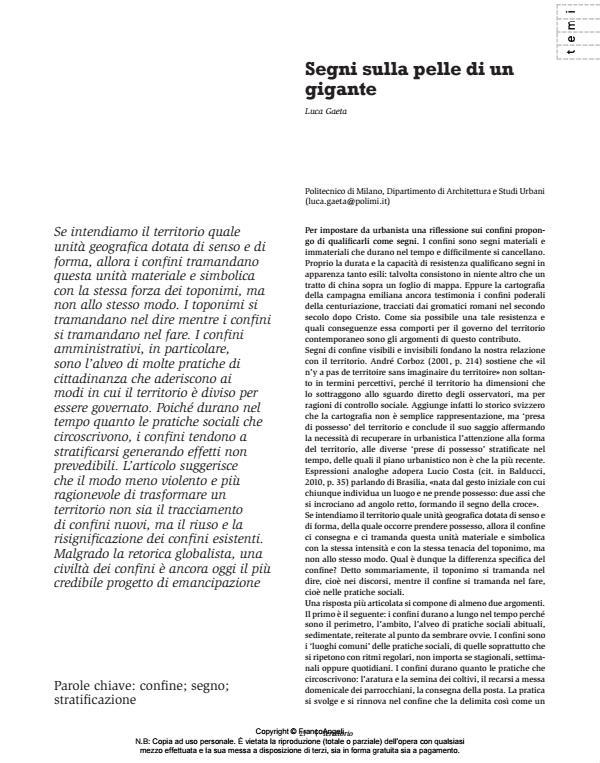Signs on the skin of a giant
Journal title TERRITORIO
Author/s Luca Gaeta
Publishing Year 2014 Issue 2013/67 Language Italian
Pages 5 P. 27-31 File size 3323 KB
DOI 10.3280/TR2013-067004
DOI is like a bar code for intellectual property: to have more infomation
click here
Below, you can see the article first page
If you want to buy this article in PDF format, you can do it, following the instructions to buy download credits

FrancoAngeli is member of Publishers International Linking Association, Inc (PILA), a not-for-profit association which run the CrossRef service enabling links to and from online scholarly content.
If a ‘territory’ is defined as a geographical unit equipped with meaning and form, then borders hand down these material and symbolic units from one generation to the next with the same strength as toponyms, but not in the same way. Toponyms hand down memories in our speech, while borders hand them down in what we do. Administrative borders in particular constitute the main guidelines for many procedures concerning citizenship which are regulated by the ways in which a territory is divided in order to be governed. Since they last over time for as long as the social practices they encompass, borders tend to form layers, which generate unpredictable effects. This paper suggests that the least violent most reasonable way of transforming a ‘territory’ is not my drawing new borders, but through reuse and by changing the signification of the existing borders. Despite all the global rhetoric, a civilisation of borders is still today the most credible design for emancipation.
Keywords: Border; sign; stratification
- Balducci A., Bruzzese A., Dorigati R., Spinelli L., 2010, a cura di, Brasilia. Un’utopia realizzata 1960-2010, Electa-Mondadori, Milano.
- Benevolo L., 2006, Storia della città, vol. 1, Laterza, Roma-Bari.
- Bernoulli H., 2006, La città e il suolo urbano, Corte del Fontego, Venezia (ed. or. 1946).
- Calise M., 2000, Il partito personale, Laterza, Roma-Bari.
- Cella G.P., 2006, Tracciare confini. Realtà e metafore della distinzione, Il Mulino, Bologna.
- Corboz A., 2001, «Le territoire comme palimpseste», in Corboz A., Le territoire comme palimpseste et autres essais, L’Imprimeur, Besançon (ed. or. 1983).
- Dematteis G., 1995, Progetto implicito. Il contributo della geografia umana alle scienze del territorio, FrancoAngeli, Milano.
- Gaeta L., 2012, «La pianificazione spaziale come arte di governo», Crios, n. 3, pp. 45-55.
- Lavedan P., 1926, Qu’est-ce que l’urbanisme? Introduction à l’histoire de l’urbanisme, Henri Laurens, Paris.
- Losano M.G., 2011, La geopolitica del Novecento. Dai Grandi Spazi delle dittature alla decolonizzazione, Bruno Mondadori, Milano.
- Pasqui G., 2008, Città, popolazioni, politiche, Jaca Book, Milano.
- Remotti F., 2010, L’ossessione identitaria, Laterza, Roma-Bari.
- Sahlins P., 1989, Boundaries. The making of France and Spain in the Pyrenees, University of California Press, Berkeley.
- Sini C., 1981, Passare il segno. Semiotica, cosmologia, tecnica, Il Saggiatore,
- Milano.
- Sini C., 2012, Il sapere dei segni, Jaca Book, Milano.
- Varzi A.C., 2005, «Teoria e pratica dei confini», Sistemi intelligenti, vol. 17, pp. 399-418.
Luca Gaeta, Segni sulla pelle di un gigante in "TERRITORIO" 67/2013, pp 27-31, DOI: 10.3280/TR2013-067004